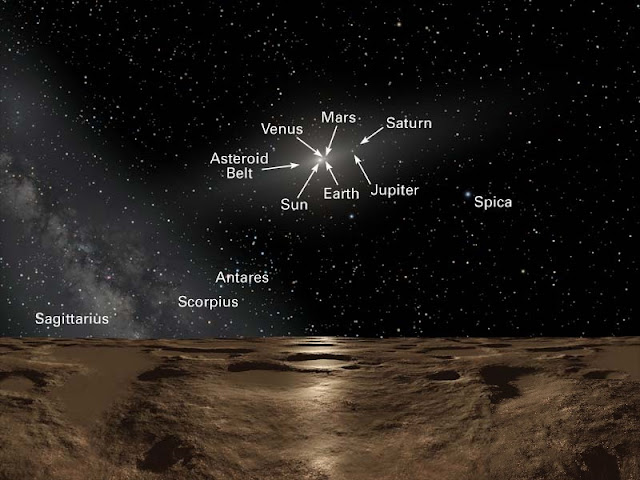This is an artist's impression of noontime on Sedna, the farthest known planetoid from the Sun. Over 8 billion miles away, the Sun is reduced to a brilliant pinpoint of light that is 100 times brighter than the full Moon. (The Sun would actually be the angular size of Saturn as seen from Earth, way too small to be resolved with the human eye.) The dim spindle-shaped glow of dust around the Sun defines the ecliptic plane of the solar system where the major planets dwell. To the left, the hazy plane of our Galaxy, the Milky Way, stretches into the sky. The background constellations are Virgo and Libra.
At this distance the Sun's feeble rays are nearly one four-thousandth the intensity of what they are at Earth. This means that Sedna is eternally cold at minus 400 degrees Fahrenheit, which means that the planetoid is airless and icy. Life, as we know it, could never live here. But if anything could survive, it would have an intriguing global view of the entire Solar System. A fifth-magnitude object, barely three degrees from the Sun (the pinpoint at the two o'clock position) is Jupiter. Saturn is also visible as a dim star. Earth would be only half a degree from the Sun and, at ninth magnitude, only be visible in powerful binoculars. To our imaginary "Sednian" astronomers, all the planets would be in inferior orbits (meaning interior to Sedna's orbit). This means they would best be seen in the predawn morning sky and post sunset evening sky, but never at midnight.
Image Credit: NASA, ESA and Adolf Schaller
Explanation from: http://hubblesite.org/newscenter/archive/releases/2004/14/image/e/





wonders of the universe
ReplyDeleteтам бесконечно светило
ReplyDelete